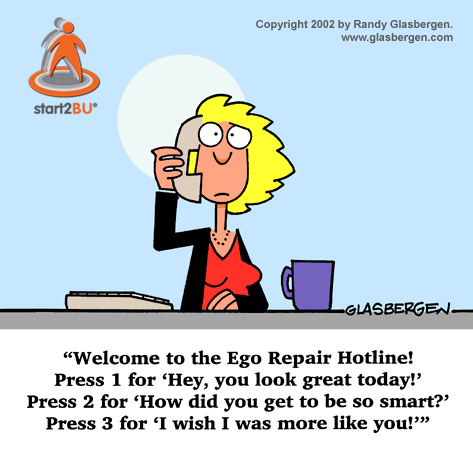A sports event in a packed stadium where everyone is dead quiet, no ecouragement….. Supporters are silent, no waving of flags, no hooters, no ‘mexican waves’ … How will the players perform ? Not very well I presume. Lacking appreciation and encouragement a player/athlete will not perform at the same level as when he’s encouraged. An audience shouting Boo ! for a poor performance is preferred over no acknowledgement at all.
And how about appreciation and recognition at work ? Are you performing in a full stadium encouraging others or being encouraged by them ? Or is a job well done taken for granted ?
Do you need to call the ‘Ego Repair Hotline’ whenever your self-esteem meter drops below the minimum level or will a peer or direct line manager give you a mental power boost so you’re up for it again ? With the right dose of recognition and appreciation at work a self-esteem meter should never drop below the line.
Appreciation exists in several forms : sincere listening, informing, show understanding, motivating, giving compliments, a pat on the back…. – in short it is an essential component of relational communication.
Recognition is a two way ‘top down’ and ‘bottom up’ communication and in order to embed it within a company culture it needs to be applied in this order. Appreciation starts from the top ! It is the key to get employees fully committed and engaged to perform to their full potential.
Two important rules concerning recognition are
When I was in my twenties my line manager used to say to me at the end of the day “Thank you for your work of today”, every single day. At first it felt uncomfortable. ‘What do you mean, I’m paid for this – isn’t this evident ?’ I thought. Over time I started to enjoy it and I was looking forward to my daily portion of recognition. Even though I was paid for doing my work, my boss acknowledged my commitment to work on a daily basis. As I became a manager I started to recognise people in the same way.
What is needed to get people more engaged at work ? Check out the Engage-me-more pyramid.
Level 1 seems simple, but oh so often neglected. It is the most basic form of recognition, seeing someone and call them by their name.
Level 2 is not as easy for everyone. Some people like it, others find it a waste of time. Yet it is an important way to find out what’s happening at work and to create a pleasant atmosphere. It breaks the ice.
Level 3 is a deeper form of recognition. Sincere listening to opinions and ideas of others, show interest in what people do.
Level 4 allows more depth as emotions and feelings get involved. Showing your own emotions and asking how people feel creates room for empathy.
Level 5 is less frequent and is at the top of the pyramid. This level of recognition will rather occur at home or in private sphere. It is less frequently present at work unless you have colleagues with whom you are friends or you have a solid working relationship. This is the person to whom you can say anything without worrying about repercussions.
Challenge yourself ! Call people by their names, have a chat, give a compliment, a pat and observe the results. Initially it will seem contrived and feel artificial. After a while it will become natural. That’s when the new behaviour will be embedded into your daily work. Good luck !
Do you find this article interesting ? Please share it with your network using the share-buttons at the end of this article or like Start2BU on facebook ! Many thanks.
To stay informed about new blog posts you can subscribe here to the Start2BU® newsletter..
Want to learn about how to be more authentic and transparent in your communication style ? Register here for the free Start2BU® online course “More authentic in 5 weeks”.
Clipart : Presentermedia, Sources : Powel, 5 levels of communication and various TA-literature amongst them ‘Einstein en de kunst van het zeilen’, De Graaf & Kunst.


